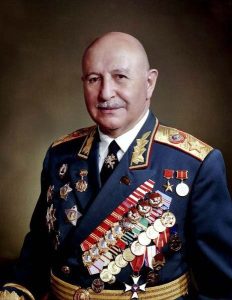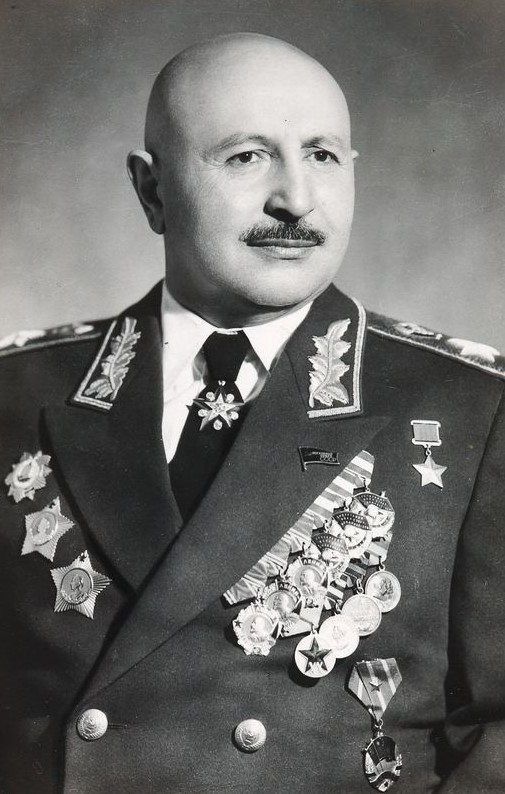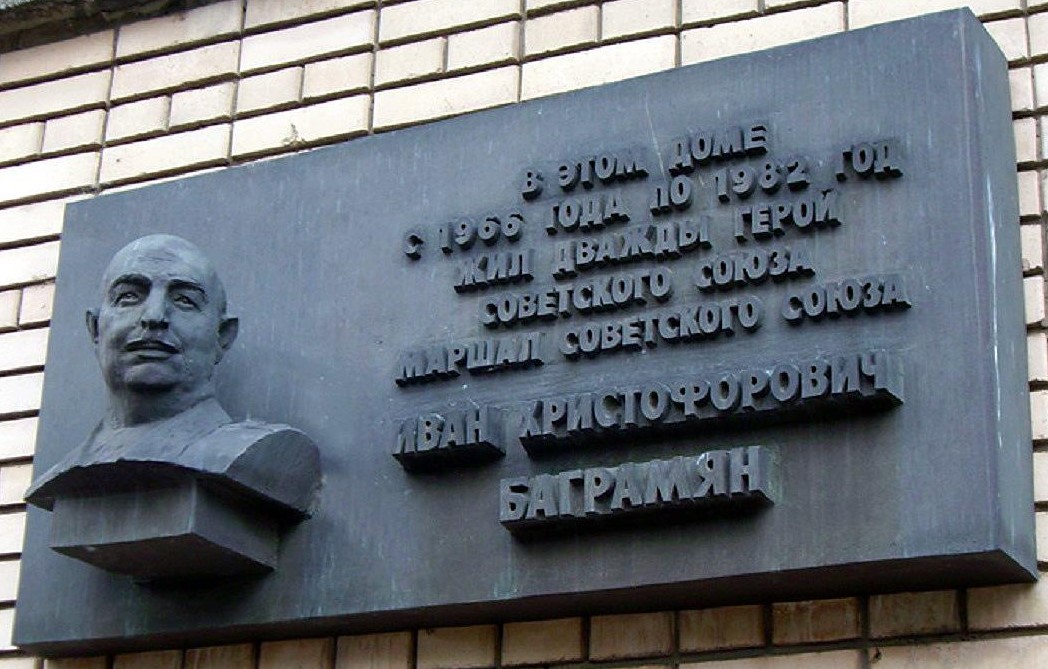Ivan Khristoforovich
Bagramyan
1897-1982

Bagramyan Ivan Khristoforovich was a Soviet military commander and leader, state and military figure, Marshal of the Soviet Union (March 11, 1955), twice Hero of the Soviet Union (July 29, 1944, December 1, 1977). He was born on November 20 [December 2], 1897, near the village of Chardakhly, Elizavetpol Uyezd, Elizavetpol Governorate, Russian Empire. He was the son of a railway worker. He received his primary education at an Armenian parish school in Elizavetpol. Then from 1907 to 1912, he studied at a railway school in Tiflis, and from 1912 to 1915 at a technical school, after which he became a practical technician. In 1915, he was drafted into the army and served in World War I, holding the rank of Ensign. He was demobilized in 1918. From 1918 to 1920, he served in the forces of the Dashnak Armenian Republic. In December 1920, he joined the Red Army as a squadron commander. He was a participant in the Civil War. From 1923 to 1924, he commanded a cavalry regiment of the Armenian Rifle Division. He received his military education at the Advanced Training Courses for Higher Command Staff (1925), the Frunze Military Academy (1934), and the Military Academy of the General Staff (1938). From 1924 to 1925, he studied alongside G.K. Zhukov and K.K. Rokossovsky. From 1931, he was chief of staff of a cavalry division in Ukraine. During the mass purges in the Red Army, material was collected against Bagramyan due to his service in the “bourgeois Armenian army.” He was saved thanks to the intercession of A.I. Mikoyan. From 1938, he was a tactics instructor at the Military Academy of the General Staff. From September 1940, he was head of the Operations Department of the headquarters of the Kiev Special Military District. In 1941, he joined the All-Union Communist Party (Bolsheviks). During the Great Patriotic War, he was deputy chief, and from April 1942, chief of staff of the Southwestern Front. From July 1942, he commanded the 16th (later 11th Guards) Army, and from November 1943, the 1st Baltic Front (November 20, 1943 – February 24, 1945). On July 29, 1944, for the successful organization of the operations of the 1st Baltic Front troops during the Belorussian Strategic Offensive, I.Kh. Bagramyan was awarded the title of Hero of the Soviet Union. Subsequently, from February 1945, he commanded the Zemland Group of Forces, and from April 1945, the 3rd Belorussian Front (April 27, 1945 – August 15, 1945). He became widely known for his successful actions near Vitebsk (June 1944). Bagramyan commanded armies and fronts throughout the Great Patriotic War. On April 19, 1945, for the operation to capture the fortress city of Königsberg and destroy a large enemy grouping, I.Kh. Bagramyan was awarded his second Order of Suvorov, 1st Class. On April 26, 1945, I.Kh. Bagramyan replaced Marshal A.M. Vasilevsky, who was departing to prepare the theater of military operations in the Far East, as commander of the 3rd Belorussian Front. Under his command, the front’s forces completed the operation to destroy the enemy Zemland grouping. On June 24, 1945, I.Kh. Bagramyan led the composite regiment of the 1st Baltic Front at the Victory Parade on Red Square in Moscow. In the post-war period, he commanded military district troops. From 1946, he was a Deputy of the Supreme Soviet of the USSR. From 1945 to 1954, he commanded the troops of the Baltic Military District. From 1952, he was a candidate member, and from 1961, a full member of the CPSU Central Committee. From 1954 to 1955, he was Chief Inspector of the USSR Ministry of Defense. From 1955, he was Deputy Minister of Defense of the USSR (1955-1956, 1958-1968), and from 1956, head of the Voroshilov Military Academy of the General Staff. From 1958, he was Deputy Minister of Defense – Chief of Logistics of the Soviet Army. From 1968, he served in the Group of General Inspectors. By decree of the Presidium of the Supreme Soviet of the USSR on December 1, 1977, for his services to the USSR Armed Forces, and the courage and heroism displayed in the fight against the German-fascist invaders during the Great Patriotic War, and on the occasion of his eightieth birthday, Marshal of the Soviet Union I.Kh. Bagramyan was awarded the Order of Lenin and a second “Gold Star” medal. During the Cuban Missile Crisis, I.Kh. Bagramyan led the development of the plan for the delivery and deployment of the Soviet troop group in Cuba and managed the operation from the Soviet side. To mislead potential adversaries into thinking the “exercises” were being prepared in the north of the USSR, the operation was codenamed “Anadyr”. For his military services, I.Kh. Bagramyan was awarded: Seven Orders of Lenin (July 29, 1944, November 6, 1945, December 1, 1947, December 2, 1957, December 2, 1967, December 1, 1972, December 1, 1977), the Order of the October Revolution (February 22, 1968), three Orders of the Red Banner (November 6, 1941, November 3, 1944, May 17, 1951), two Orders of Suvorov, 1st Class (August 27, 1943, April 19, 1945), the Order of Kutuzov, 1st Class (April 9, 1943), the Order “For Service to the Homeland in the Armed Forces of the USSR”, 3rd Class (April 30, 1975), an honorary named weapon with a golden image of the State Emblem of the USSR (February 22, 1968), a Damascus saber – a gift from the Armenian people, many medals of the USSR, and many orders and medals from foreign states. He was the author of 7 memoir books, including “The Great Victory of the Soviet People” (1970).
Address: Moscow, Sivtsev Vrazhek lane, 31/13

